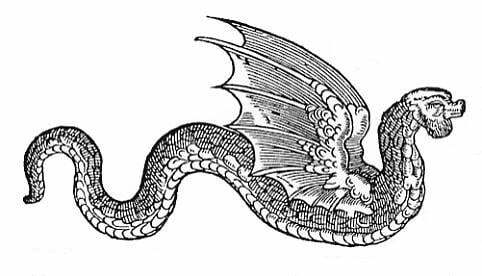Amphiptere, the Sky-Serpent of Silent Death
“Swooping from the skies with a serpent’s grace and a dragon’s fury, the Amphiptere is the silent death you’ll never hear coming!”
The Amphiptere is a sleek, serpentine dragon with a body covered in iridescent scales that shimmer from emerald green to bronze in sunlight. Stretching up to 20 feet in length, it lacks legs, slithering through the air like a ribbon caught in the wind. Its wings, broad and feathered like those of a giant raptor, extend from powerful shoulder joints just behind the neck. The head is elongated, featuring a hooked beak, slitted eyes that glow like molten gold, and a crown of fine quills or crests used in threat displays. The tail ends in a barbed or spade-like tip used for aerial maneuvering or whipping prey.
Behavior
Amphipteres are swift, territorial, and silent predators. They rarely vocalize, preferring to communicate through body language, low-frequency vibrations, and wing postures. Solitary by nature, they spend most of their time in the air or coiled around high perches, scanning for prey. They are ambush hunters, striking with blinding speed and retreating before a target can react. Though intelligent, they lack the complex social structure of true dragons.
They are intensely curious and will observe humanoids from a distance for hours, often mimicking their behaviors in secret. While not inherently malicious, Amphipteres are easily provoked and will not tolerate intrusions into their hunting grounds.
Habitat
Amphipteres favor high-altitude environments, such as the craggy peaks of storm-lashed mountains, cliffside ruins, or ancient treetop canopies in deep jungles. Their lairs are often precariously located on sheer cliffs, reachable only by flight. These lairs are lined with feathers, bones, and shiny objects — not out of greed, but as a result of their instinctive hoarding of aesthetically pleasing items.
They are rarely seen at ground level unless drawn by prey, a wounded mate, or a threat to their territory.
Modus Operandi
An Amphiptere hunts by gliding silently on thermals, using its keen vision to spot movement from miles away. Once prey is identified, it dives in near-silence, aiming to immobilize with its venomous bite or whip-like tail strike. Their venom causes temporary paralysis and hallucinations, making capture and feeding effortless.
After the kill, the Amphiptere will often coil around its victim, consume it slowly, and remain in place for hours to digest, relying on its natural camouflage to remain hidden.
If engaged in combat, the Amphiptere uses hit-and-run tactics: diving, striking, then soaring away before a counterattack can be made. It rarely fights to the death unless cornered or guarding a clutch of eggs.
Motivation
The Amphiptere is driven by primal urges: territorial dominance, acquisition of beauty, and protection of its solitude. Though not evil, its alien mindset and silence make it unsettling to encounter. Some scholars believe Amphipteres possess a latent psychic sense of harmony or disharmony in their surroundings — drawn to places of ancient magic or great imbalance.
Legends speak of Amphipteres watching over forgotten temples or haunting ruined observatories, as though drawn to mysteries long buried by time. Those who win their respect — a rare feat — may find themselves trailed silently from the sky, protected from unseen threats by an invisible guardian.
Amphiptere 5e
Amphiptere, Pathfinder
Amphiptere
Medium Dragon, Unaligned
Challenge 7 (2,900 XP) Proficiency Bonus +3
Armor Class 16 (natural armor)
Hit Points 126 (12d8 + 72)
Speed 0 ft., fly 80 ft. (hover)
| STR | DEX | CON | INT | WIS | CHA |
|---|---|---|---|---|---|
| 16 (+3) | 20 (+5) | 22 (+6) | 6 (−2) | 14 (+2) | 12 (+1) |
Saving Throws Dex +8, Wis +5
Skills Perception +5, Stealth +8, Survival +5
Damage Resistances Cold, Fire, Lightning
Senses Darkvision 120 ft., Passive Perception 15
Languages Understands Draconic but cannot speak
Traits
Aerial Grace.
The amphiptere can hover and turn mid-flight without using extra movement. While airborne, its AC increases by 1 against ranged weapon attacks.
Silent Predator.
While flying, it makes no sound unless it chooses to. It has advantage on Dexterity (Stealth) checks made to remain unheard.
Venomous Fangs.
A creature that fails a saving throw against the amphiptere’s Venomous Bite is also poisoned for 1 minute. While poisoned this way, the creature suffers mild hallucinations and has disadvantage on Wisdom (Perception) checks.
Actions
Multiattack.
The amphiptere makes two attacks: one with its Venomous Bite and one with Tail Lash, or two with Tail Lash.
Venomous Bite. Melee Weapon Attack: +6 to hit, reach 5 ft., one target.
Hit: 11 (2d6 + 4) piercing damage, and the target must succeed on a DC 16 Constitution saving throw or take 13 (3d8) poison damage and be poisoned for 1 minute. The poisoned target can repeat the saving throw at the end of each of its turns, ending the effect on a success. While poisoned in this way, the creature perceives subtle hallucinations and has disadvantage on Perception and Insight checks, and it can’t take reactions.
Tail Lash. Melee Weapon Attack: +8 to hit, reach 10 ft., one target.
Hit: 15 (2d10 + 4) bludgeoning damage. If the target is Large or smaller, it must succeed on a DC 14 Strength saving throw or be pushed 10 feet and knocked prone.
Dive and Rend (Recharge 5–6).
The amphiptere dives toward a creature it can see within 60 feet. It moves up to its fly speed in a straight line and makes a Venomous Bite attack with advantage. On a hit, the target is grappled (escape DC 14), and the amphiptere can carry the creature up to half its fly speed without provoking opportunity attacks.
Bonus Actions
Wingbeat Escape (Recharge 4–6).
The amphiptere beats its wings and dashes 40 feet in any direction without provoking opportunity attacks. Each creature it passes within 5 feet of must succeed on a DC 14 Dexterity saving throw or be blinded until the end of its next turn by debris and dust.
Reactions
Veil of Feathers (1/Day).
When the amphiptere would be hit by a ranged attack, it may blur its form with a violent twist of feathers. It gains resistance to the triggering attack’s damage and becomes invisible until the end of its next turn or until it makes an attack.
Lair Actions
When in its lair—typically a high cliffside nest or jungle ruin—the amphiptere can invoke environmental effects. On initiative count 20 (losing initiative ties), it can take one of the following lair actions:
- Hallucinogenic Mists. Wisps of green mist swirl through the air. Each creature of the amphiptere’s choice within 60 feet must succeed on a DC 14 Constitution saving throw or experience minor hallucinations for 1 minute. A hallucinating creature has disadvantage on Insight checks and ranged attack rolls.
- Sudden Gust. A violent gust of wind erupts. Each creature on the ground within 30 feet must succeed on a DC 14 Strength saving throw or be pushed 15 feet and knocked prone.
- Aerial Ambush. Until the start of the next round, the amphiptere can take the Hide action as a bonus action while flying in dim light or obscuring terrain.
Amphiptere

This snake-bodied dragon has a sinuous tail with a spiked tip. Flared wings attach to its forelimbs, and it lacks rear legs.
Amphiptere CR 4
XP 1,200
N Large dragon
Init +4; Senses darkvision 60 ft., low-light vision, scent; Perception +13
DEFENSE
AC 16, touch 9, flat-footed 16 (+7 natural, –1 size)
hp 42 (5d12+10)
Fort +6, Ref +4, Will +5
Immune paralysis, sleep
OFFENSE
Speed 10 ft., fly 60 ft. (average)
Melee tail +9 (1d8+4), bite +8 (1d10+4 plus grab), 2 wings +3 (1d4+2)
Space 10 ft.; Reach 5 ft. (10 ft. with tail)
Special Attacks constrict (1d10+4), impale
STATISTICS
Str 18, Dex 11, Con 14, Int 7, Wis 12, Cha 9
Base Atk +5; CMB +10; CMD 20 (can’t be tripped)
Feats Flyby Attack, Improved Initiative, Weapon Focus (tail)
Skills Fly +10, Perception +13, Sense Motive +9, Stealth +4; Racial Modifiers +4 Fly, +4 Perception
Languages Draconic
SQ limited flight
SPECIAL ABILITIES
Impale (Ex)
If an amphiptere confirms a critical hit with its tail attack against a creature smaller than itself, the spike-tipped tail impales the target creature.
An impaled creature gains the pinned condition (though the amphiptere doesn’t gain the grappled condition), takes 1d6 points of bleed damage, and automatically takes damage from the amphiptere’s tail each round it remains pinned. An amphiptere can’t constrict a creature it has impaled, nor can it use its tail attack while it is impaling a creature, but it doesn’t need to succeed at a grapple combat maneuver check to maintain the grapple. An amphiptere can release an impaled creature as a free action.
Limited Flight (Ex)
Though amphipteres have wings, they can’t truly fly. Amphipteres usually move by lifting themselves a few feet off the ground with their great batlike wings and pulling themselves along the ground with their claws. This tactic provides an amphiptere a fly speed of 60 feet and average maneuverability, though they can’t lift themselves higher than 10 feet off the ground and can’t use their wings to hover.
Additionally, amphipteres can attempt a DC 15 Fly check to fall safely from any height without taking falling damage, as if under the effects of feather fall. When falling safely, an amphiptere can attempt an additional DC 15 Fly check to glide, allowing it to move 5 feet laterally for every 10 feet it falls.
ECOLOGY
Environment temperate or warm deserts, hills, or mountains
Organization solitary, pair, or flight (3–18)
Treasure standard
Distantly related to wyverns, amphipteres are equally cruel and prone to violence. Like wyverns, they have serpentine bodies and bat-like wings. Unlike wyverns, however, amphipteres must use the long claws on the tips of their wings to propel their bodies along as they awkwardly leap and soar a few feet off the ground. They’re also longer and much leaner than wyverns, and instead of a wyvern’s poisonous stinger, an amphiptere has a broad, arrow-shaped spur at the end of its long tail. Capable of piercing armor and shattering bone, an amphiptere’s tail skewers prey much like a fisher might spear a fish.
Amphipteres average 18 feet in length, though most of this length is the tail, and they weigh around 1,600 pounds.
Section 15: Copyright Notice
Pathfinder Player Companion: Weapon Master’s Handbook © 2015, Paizo Inc.; Authors: Alexander Augunas and David N. Ross.

 Buy me a coffee
Buy me a coffee